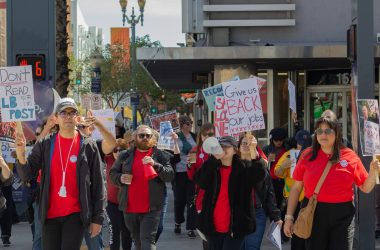The city of Long Beach recently announced the results of the 2017 Biennial Homeless Count to reveal a 21 percent reduction in the total number of persons experiencing homelessness in the city. Despite the decrease, some Long Beach residents feel that they have noticed no change.
“If you go down an alleyway in the city, then chances are you’ll see homeless people scanning the cans or pushing their carts around,” said junior marine biology major and Long Beach resident Xavi Harper, who lives on Seventh Street in westside Long Beach.
Still, city officials are adamant that homelessness is down across the board.
“We know that sentiments of residents are opposite of what the results show,” said Elsa Ramos, coordinator of the Multi-Service Center for the Homeless.
According to city officials, in 2015 there were over 2,300 homeless people living in Long Beach, while today there are closer to 1,800. Ramos attributes the drop in homeless residents to the numerous beautification efforts happening throughout the city, mainly the cleanup along the Los Angeles River corridor.
The LA River was a hotbed for homelessness. Throughout LA County, hundreds of people have sought the river as a temporary or permanent living solution. With the beautification initiatives and cleanup, a large concentration of homeless people in the Long Beach area have been forced to disperse elsewhere.
“This population shift has led some to believe there is an overall increase in homelessness, when in actuality there are fewer homeless individuals,” city officials said in a press release. However, some of the population has shifted to areas outside of traditional concentration areas.
“When I lived with my sister in Long Beach in 2014 between Ocean [Boulevard] and [East] Broadway, not far from where I am now, I don’t remember seeing homeless people as often as I do over here,” said Jacob Handy, 23.
Handy, who has lived in the city on and off since 2014, can attest to the increased visibility of homeless being spotted in nontraditional areas.
Now living with his twin brother in the same area, Handy says he sees a few displaced people every now and then, noting one regular gentleman who stations himself outside of the local market.
“He seems like he might have a mental disability, but the people at the market are cool with him and they let him hang out awhile,” Handy said.
The term “homeless” is a catch-all phrase meant to help categorize, not erase, underlying issues, according to Long Beach Fourth District Councilman Daryl Supernaw.
“I don’t ever want to downplay the severity of this issue. These people are not all homeless, they also might be struggling with mental illness or addiction,” said Supernaw. “The practical way of dealing with this is providing them with resources to help them get off the streets.”
Allison King, Bureau Manager of the Long Beach Housing Authority, agrees that an increase in city support services is a potential solution to the predicament.
“I think it’s important to get the root level services in for those who need it,” King said. “There are a number of ways that you can do it, but when you locate a lot of indigent people together you have to have supportive services available. A social worker, occupational therapist or someone who can help with life skills to be able to ensure that people are being referred to services that they need.”
According to data from the newly launched Homelessness Education And Response Team, a subprogram of the Long Beach Fire Department known as HEART, by far the majority of calls coming from the downtown, second or third districts were medical-related calls.
New models of outreach like HEART have helped Long Beach report a reduction in homelessness for a fourth consecutive year. However, Ramos notes that there is more work to be done in the fight to end homelessness in the city.
“There are 1,200 people still out there,” said Ramos. “The most difficult people to engage are those with mental health issues or disabled, who sometimes refuse linkages to services for housing. In this respect, the process is much lengthier.”




